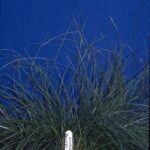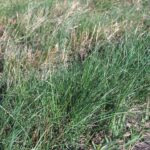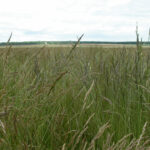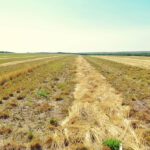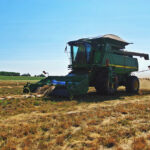Creeping Red Fescue
Festuca rubra
General Description
Creeping red fescue is a long-lived, hardy, creeping rooted, cool season perennial grass, important for its use in stabilizing soil, as stockpiled forage, as blending for the turf industry, and as a seed crop the cool, moist regions. Creeping red fescue root systems are fibrous with short rhizomes. Roots form a thick sod that is resilient to traffic, but they are less dense than smooth bromegrass or Kentucky bluegrass.
Stems are up to 90 cm (35 in) tall and are often reclining at the base. Creeping red fescue mostly produces basal leaves. Leaves are 5 to 15 cm (2 to 6 in) long. Seed heads are up to 15 cm (6 in) and branch mostly upright. Spikelets are up to 15 mm long and 4-8 are flowered, producing purple-tinged flowers.
Stems are up to 90 cm (35 in) tall and are often reclining at the base. Creeping red fescue mostly produces basal leaves. Leaves are 5 to 15 cm (2 to 6 in) long. Seed heads are up to 15 cm (6 in) and branch mostly upright. Spikelets are up to 15 mm long and 4-8 are flowered, producing purple-tinged flowers. The upper surface is deeply ridged, and the undersurface is shiny. The collar is narrow and continuous. There are no auricles. The ligule is a very short membrane. The stems are nearly round. Its most distinguishing features are dark-green, very slender and bristle-like leaves; old, dead basal leaf sheaths are reddish brown (hence the common name).
Type
Tame grass.
Origin
Native to Europe and North America. Varieties developed in Canada.
Longevity
At least 20 years.
Use
Pasture, stockpiled, reclamation.
Optimal Time of Use
Spring, summer, fall, winter. Creeping red fescue can be continually or rotationally grazed. It remains palatable and nutritious year-round. Snow cover may restrict stockpiled grazing in some areas as it is low growing Leave at least 5 cm (2 in) for regrowth to occur.
Recovery After Use
Requires a minimum 30-45 days of recovery after use. This time is highly variable depending on the moisture conditions. Recovery is usually good as growing points are often below grazing level, especially if not continuously grazed. Forage trials indicate that rest after a mid-July grazing on creeping red fescue should allow for adequate growth for stockpiled use. Manage creeping red fescue with adequate rest to decrease Kentucky bluegrass invasions.
Palatability/Nutritional Value
Creeping red fescue is palatable and holds its quality year round. It has average total digestible nutrients of 61% and 12% crude protein in the vegetative state. Creeping red fescue is not only palatable in the fall but also over winter, into the spring. When stockpiled, this species has adequate nutrition for a dry pregnant cow.
Annual Precipitation min/max (mm)
700mm / 1775mm. Does poorly under low precipitation but is noted to survive under lower minimum precipitation (400mm).
Drought Tolerance
Fair to moderate drought tolerance.
Flooding Tolerance
Withstands 2 to 5 weeks of spring flooding or waterlogged soils.
Winter Hardiness
Excellent hardiness.
Soil Texture Preference
Creeping red fescue can be grown on a wide range of soils as long as moisture is available. It is most suited to sandy, loamy, and clay soils in the Black and Gray soil zones.
Creeping red fescue can be grown on a wide range of soils as long as moisture is available. It is most suited to sandy, loamy, and clay soils.
Erosion Control
High erosion control. A good species for controlling erosion and often used for revegetation of waterways and canals since it forms a thick, soil-binding sod, but does not impede water movement.
Salinity Tolerance
Moderate tolerance.
Acidity Tolerance
High tolerance.
Alkalinity Tolerance
Moderate tolerance.
Seeds per kg
826,000 seeds/kg (375,000 seeds/lb)
Suggested Mixtures
Complements timothy, smooth bromegrass, alsike clover, alfalfa and cicer milkvetch.
Complements timothy, smooth bromegrass, alsike clover, alfalfa and cicer milkvetch, alsike clover, and alfalfa.
Ease of Establishment
Seedlings are vigorous, and creeping red fescue is relatively easy to establish.
Competitiveness
Creeping red fescue is competitive in moist areas. Low invasiveness. As it is shade tolerant, it can remain productive with taller forage species.
Management Considerations
Use appropriate stocking rates and allow rest following grazing. Kentucky bluegrass can invade and overtake creeping red fescue stands if management is not considered. Creeping red fescue may increase in abundance if seeded with other less competitive species in a pasture mix.
British Columbia Rangeland Seeding Manual, Saskatchewan Dryland Forage Species Adaptation Tool, USDA Plants Database, Manitoba Forage Adaptation Tables, Alberta Forage Manual
Creeping red fescue is adapted to the Sub-Boreal Spruce zone and wetter areas of the Sub-Boreal Pine-Spruce, Interior Douglas-fir and the Interior Cedar-Hemlock zones.
Creeping red fescue is adapted to wetter areas of the Interior Douglas-fir zone and the Interior Cedar-Hemlock zone.
